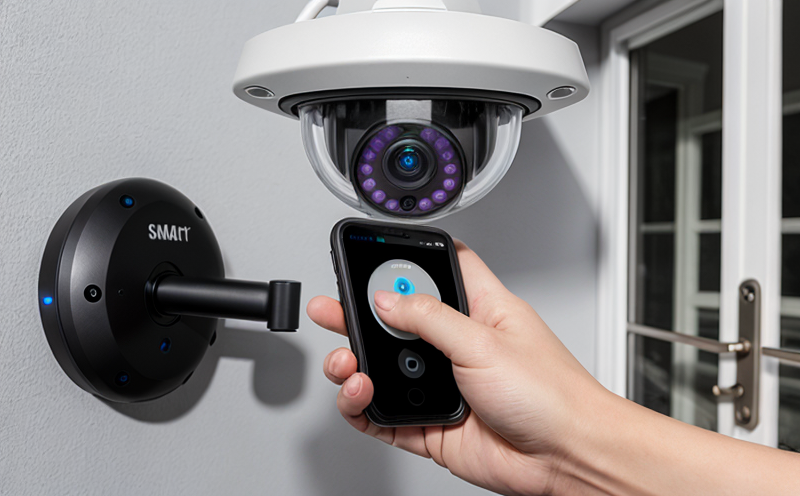ASTM F3016 Intrusion Resistance Testing of Smart Security Devices
The ASTM F3016 standard is specifically designed to assess the resistance of smart security devices to unauthorized entry. This test is critical for ensuring that security systems are effective in preventing intrusions, which can be a significant concern in residential and commercial settings.
Smart security devices such as door locks, window sensors, and motion detectors are increasingly being integrated into modern homes and businesses. These devices often rely on advanced technologies like wireless communication, biometric recognition, and machine learning algorithms to enhance security. However, the effectiveness of these systems can be compromised by sophisticated intrusion techniques, which is where ASTM F3016 comes into play.
The test aims to evaluate how well a smart security device can resist various forms of unauthorized access attempts. This includes simulating real-world scenarios that an intruder might employ, such as picking locks, bypassing sensors, or exploiting software vulnerabilities. By subjecting the device to these simulated attacks, manufacturers and quality managers can identify weaknesses in their products' design and functionality.
The ASTM F3016 test protocol is rigorous and comprehensive, ensuring that it provides accurate and reliable results. The test setup typically includes a series of controlled environmental conditions that mimic potential intrusion situations. This allows for the assessment of both physical and digital security measures employed by the device.
One of the key aspects of ASTM F3016 testing is the use of various tools and methods to simulate an intruder's approach. These can range from simple jemmy bars used to pick locks manually, to more advanced electronic devices designed to bypass electronic sensors. The test also evaluates the integrity of software components that control the device, ensuring they remain secure against unauthorized access.
The results of ASTM F3016 testing are essential for several stakeholders within a company. Quality managers can use these findings to improve product design and manufacturing processes. Compliance officers ensure adherence to regulatory standards while R&D engineers gain insights into potential improvements in future iterations of smart security devices. Procurement teams may also benefit by using this information to make informed decisions about the suppliers they choose.
In summary, ASTM F3016 Intrusion Resistance Testing is a vital tool for ensuring that smart security devices meet stringent industry standards and provide reliable protection against unauthorized access attempts. By incorporating this test into their quality control processes, companies can enhance customer confidence in their products and maintain competitive advantage in the market.
Scope and Methodology
| Parameter | Description |
|---|---|
| Intrusion Simulation Methods | Various techniques including physical lock picking, bypassing sensors, and exploiting software vulnerabilities. |
| Test Setup Conditions | Controlled environmental conditions that simulate real-world intrusion scenarios. |
| Measurement Criteria | Evaluation of the device's ability to resist unauthorized access attempts across multiple dimensions. |
| Data Collection | Comprehensive data recording, including video and photographic evidence of test results. |
| Reporting Requirements | Detailed reports outlining all aspects of the test, including any observed vulnerabilities or weaknesses. |
| Repeatability | The process ensures consistent testing outcomes under identical conditions. |
| Acceptance Criteria | Specific thresholds defining what constitutes an acceptable level of security performance. |
Why Choose This Test
The ASTM F3016 Intrusion Resistance Testing is a crucial component in the development and validation of smart security devices. By subjecting these devices to rigorous testing, manufacturers can identify and address potential weaknesses early in the product lifecycle. This proactive approach not only enhances the overall security performance but also helps prevent costly recalls or warranty claims later on.
For quality managers, the test provides valuable insights into areas where improvements are needed. They can use this information to refine manufacturing processes and ensure that each device meets high standards of reliability and durability. Compliance officers benefit from having a robust testing framework in place, which ensures adherence to relevant regulations and industry best practices.
R&D engineers gain critical feedback on their designs through ASTM F3016 testing, allowing them to innovate continuously and stay ahead of emerging threats. Procurement teams can leverage this information when selecting suppliers who demonstrate commitment to quality and security excellence. Ultimately, choosing ASTM F3016 Intrusion Resistance Testing ensures that smart security devices are not only innovative but also trusted by end users.
Moreover, the test contributes significantly to environmental sustainability efforts by promoting the use of secure products that reduce the need for frequent replacements due to security breaches or failures. This translates into lower waste generation and reduced resource consumption over time. Additionally, the increased confidence in product quality fostered by this testing can lead to higher customer satisfaction rates, which is beneficial for brand reputation.
In conclusion, ASTM F3016 Intrusion Resistance Testing offers numerous advantages that make it an indispensable part of any comprehensive quality assurance program for smart security devices. Whether you are a manufacturer looking to enhance product performance or a consumer seeking peace of mind, this test provides the foundation needed to achieve these goals.





